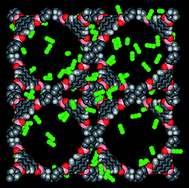Exceptionally high CO2storage in covalent-organic frameworks: Atomistic simulation study†
Abstract
Atomistic simulations have been performed on CO2storage in covalent-organic frameworks (COFs) including 3D (COF-102, COF-103, COF-105, and COF-108), 2D (COF-6, COF-8, COF-10) and 1D (COF_NT) structures. Compared to 2D and 1D COFs, 3D COFs have substantially larger free volume, porosity and surface area. As a counterbalance of low framework density and large porosity, COF-105 and COF-108 show exceptionally high storage capacity, even surpassing the experimentally measured highest capacity in MOF-177. COF-6 exhibits the largest isosteric heat and Henry constant due to the presence of constricted pores, but the lowest saturation capacity. COF_NT has


 Please wait while we load your content...
Please wait while we load your content...